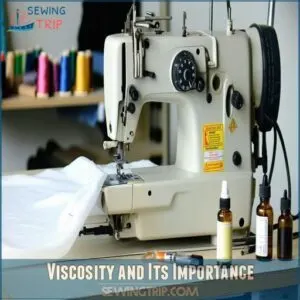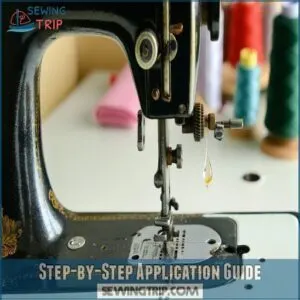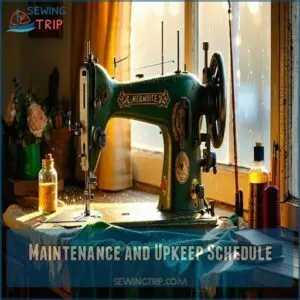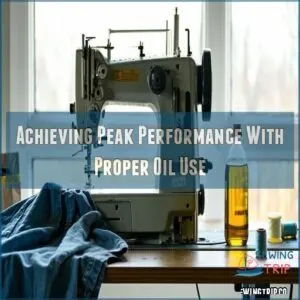This site is supported by our readers. We may earn a commission, at no cost to you, if you purchase through links.
 Keep your sewing machine running smoothly with the right oil. Several standout brands will keep your machine purring like a well-fed cat.
Keep your sewing machine running smoothly with the right oil. Several standout brands will keep your machine purring like a well-fed cat.
Sewing Machine Stainless Oil Zoom leads the pack with an impressive 4.7-star rating from over 4,000 sewists.
Juki Sewing Machine Serger Oil offers versatile performance across all machine types. Crystal Clear Lubricating Oil won’t leave residue on your fabrics.
For those hard-to-reach spots, consider the Lubricant Oil Spray or ZOOM SPOUT with its adjustable spout and crystal-clear formula. Just like your machine’s moving parts, choosing the right oil is all about smooth operation.
Table Of Contents
Key Takeaways
- You’ll need proper sewing machine oil for smooth operation – top brands include Sewing Machine Stainless Oil Zoom with its 4.7-star rating, and Juki Sewing Machine Serger Oil, which works across all machine types.
- Your machine requires regular maintenance with oil that matches its specifications – check your manual for the right viscosity grade and never substitute with household lubricants like WD-40, which can damage internal components.
- You can extend your machine’s lifespan by applying 1-2 drops of oil at designated points monthly (or biweekly in humid climates), and always wipe excess oil to prevent fabric staining.
- You’ll get optimal performance by storing your oil in a cool, dark place, replacing unused oil every 12-18 months, and using it within its ideal temperature range of 20°F to 140°F (-6°C to 60°C).
Importance of Sewing Machine Oil
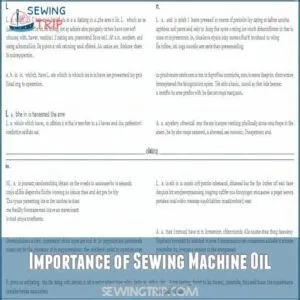
Just as your car needs regular oil changes, your sewing machine craves quality lubrication to maintain smooth, quiet operation and extend its lifespan.
You’ll need proper sewing machine oil to prevent your beloved machine from sounding like a rusty robot while protecting its moving parts from wear and tear.
How Oil Affects Performance
Think of your sewing machine as a finely-tuned engine – proper oil viscosity is essential for peak performance. When you use the right sewing machine oils, you’ll notice an immediate difference in how smoothly everything runs.
Proper sewing machine maintenance also plays a critical role in extending its lifespan.
Here’s what quality machine oil does for your sewing:
- Maintains consistent stitch quality by regulating thread tension and speed variations
- Reduces noise and creates smoother operation at higher speeds
- Guarantees all moving parts glide effortlessly, preventing stuttering or jamming
Prevention of Wear and Tear
Regular maintenance with quality sewing machine oil brands does more than keep things running—it’s your machine’s shield against wear and tear.
By creating a protective barrier between metal parts, you’ll reduce friction and prevent corrosion that can eat away at your investment.
Think of it as armor for your machine’s moving parts, extending its lifetime while maintaining smooth operation through every stitch you make.
Reduces Noise and Vibration
When your sewing machine suddenly sounds like a jackhammer, you’ll appreciate the magic of quality sewing machine oil brands. Proper friction control, achieved with quality oil, leads to significant vibration damping and noise reduction, ensuring smooth stitching and quiet operation.
- Your machine purrs like a contented cat
- Neighbors stop asking if you’re renovating
- You can finally hear your audiobooks while sewing
- Late-night projects won’t wake the household
- Confidence soars with every whisper-quiet stitch
Top 5 Sewing Machine Oil Brands
Whether you’re a beginner or a seasoned pro, you’ll find our carefully selected top 5 sewing machine oils.
These trusted brands have earned their spots through consistent performance and positive user feedback.
They keep your precious machine running smoothly and quietly, just like the day you bought it.
1. Sewing Machine Stainless Oil Zoom

The Sewing Machine Stainless Oil Zoom stands out with its impressive 4.7-star rating from over 4,000 Amazon reviews, while many oils promise peak performance.
Its high-viscosity formula and extendable spout make reaching those tricky spots in your machine a breeze. The non-staining, crystal-clear oil delivers precise lubrication where you need it most.
Though some users have reported occasional leakage issues at the spout junction, the oil’s quality and performance make it a top choice for both beginners and seasoned sewists alike.
Best For: Sewers of all skill levels seeking a high-quality, easy-to-apply oil for their machines, especially those who need to reach tight spots.
- High viscosity formula and extendable spout for precise application.
- Non-staining and clear, ensuring your projects stay pristine.
- Highly rated by thousands of users, indicating overall satisfaction.
- Some users have reported leakage issues.
- High viscosity might not be suitable for all sewing machine types.
- Price point might be higher than some other sewing machine oils.
2. Juki Sewing Machine Serger Oil
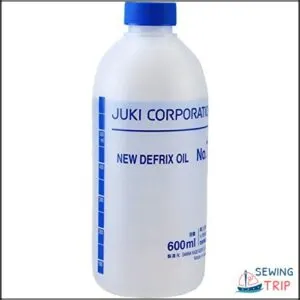
Juki’s Defrix No.
1 oil is a versatile powerhouse in the sewing world, earning impressive ratings across thousands of Amazon reviews. It’s earned a stellar reputation among sewists for its reliability and genuine formulation that keeps your machine running smoothly and quietly.
The Japanese-made oil is particularly effective for Juki J-150 and 9000C models, though it works seamlessly with all makes and sergers. It’s available in both 60ml and 600ml bottles.
The 60ml option has garnered an exceptional 4.8/5 rating from over 600 satisfied users.
Best For: Sewists of all levels, especially Juki owners, seeking a high-quality oil for smooth and quiet machine operation.
- Compatible with all sewing machine and serger makes and models.
- Available in two convenient sizes (60ml and 600ml).
- Highly rated by thousands of users on Amazon, indicating proven performance.
- Specific material composition not explicitly stated in provided information.
- Potential fill level inconsistencies mentioned in some product reviews.
- Opening the larger bottle may require extra tools or effort.
3. Sewing Machine Lubricating Clear Oil
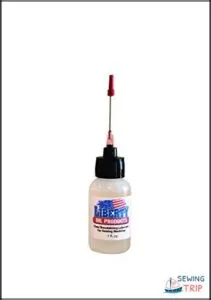
Liberty Oil’s Sewing Machine Lubricating Clear Oil consistently tops the charts, delivering exceptional performance with its stainless steel precision tip. It’s perfect for loosening seized parts and reaching those tricky spots in your machine.
This low-viscosity formula won’t leave any greasy residue on your precious fabrics. The 4-ounce bottle packs enough punch to keep your machine running smoothly, though a little goes a long way.
With a stellar 4.7-star rating from over 4,000 users, this lubricating oil offers great value and proven results.
Best For: Sewing enthusiasts and professionals looking for a high-quality, low-viscosity lubricating oil for their machines.
- Excellent lubrication for sewing machine parts, including hard-to-reach areas.
- Low viscosity formula prevents staining and residue on fabrics.
- Highly rated by thousands of users, indicating proven effectiveness.
- Potential leakage issues if the applicator tip is not secured properly.
- Excessive oil can damage fabric or machine parts.
- May not be suitable for all sewing machine types or high-heat applications.
4. Sewing Machine Lubricant Oil Spray
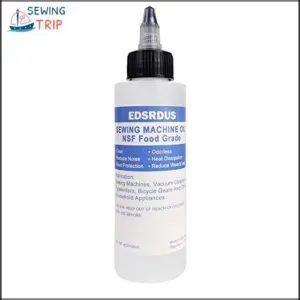
For those hard-to-reach spots in your sewing machine, spray lubricants offer a practical solution. Modern spray oils like Tri-Flow come equipped with Teflon, providing superior coverage and protection for your machine’s moving parts. These sprays are particularly useful for preventing rust and abrasion while guaranteeing smooth operation.
While convenient for quick maintenance, remember to use them sparingly. Most newer machines need minimal lubrication.
If you’re working with a computerized model, double-check your manual to confirm spray compatibility.
Best For: Anyone looking for a convenient way to lubricate hard-to-reach areas in their sewing machine, especially those with older models or complex mechanisms.
- Easy application for hard-to-reach spots.
- Superior protection against rust and abrasion.
- Ensures smooth operation of moving parts.
- Can be messy if not used sparingly.
- Not ideal for computerized machines, always check the manual first.
- May not be necessary for newer machines requiring minimal lubrication.
5. ZOOM SPOUT Sewing Machine Oil
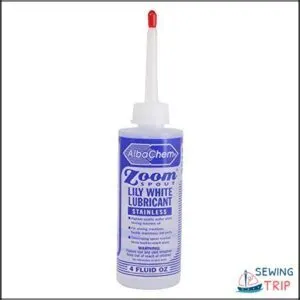
Anyone seeking a reliable sewing machine oil will find a gem in ZOOM SPOUT’s crystal-clear formula. Made in the USA, this highly refined, non-detergent mineral oil comes with an adjustable spout that reaches those tricky spots in your machine.
Its thin consistency guarantees smooth operation without staining your precious fabrics. The odorless, 4-ounce bottle packs quite a punch, preventing rust while keeping dust at bay.
You’ll appreciate its versatility – it’s perfect for both home and industrial machines, and users even report success with roller skate bearings and 3D printers.
Best For: Sewers, quilters, and anyone with sewing machines, plus those with roller skates, 3D printers, or other small appliances needing lubrication.
- Crystal-clear, non-detergent formula is safe for fabrics and prevents rust.
- Extendable spout allows for precise application in hard-to-reach areas.
- Versatile and works well on various machines and devices beyond sewing machines.
- Specific viscosity may not be ideal for all sewing machine types.
- Small bottle may require frequent repurchasing for heavy users.
- Plastic bottle could be more eco-friendly.
Key Factors to Consider When Choosing Oil
Choosing the right type of oil for your sewing machine is crucial for its smooth operation and longevity, preventing costly repairs down the line. This is true whether you’re a seasoned seamstress or just starting out with your crafting journey.
Understanding the key factors in selecting sewing machine oil will help maintain your machine’s performance and extend its lifespan. It’s not just about using any oil; your machine needs the right type to truly purr.
Viscosity and Its Importance
- Low viscosity oils glide effortlessly through tight spaces, keeping your machine purring like a kitten.
- The right viscosity grade prevents residue buildup and keeps your machine’s moving parts dancing in perfect harmony.
- Synthetic oils maintain their flow properties even when temperatures fluctuate.
For ideal performance, consider oil with a viscosity grade that suits your machine type, as specified in its manual, Sewing Machine Oil Viscosity.
Compatibility With Your Machine
Compatibility is key to proper sewing machine maintenance. Your sewing machine model, whether it’s a vintage Singer or modern Brother, requires specific oil types for ideal performance.
Check your manual recommendations carefully – using incompatible oil can damage internal components. While Janome machines may work well with one brand, Juki models could require different oil viscosity, and using the correct sewing machine oil is vital for longevity.
Don’t just grab any sewing machine oil brands off the shelf.
Quality of The Oil
Now that you know which oils work with your machine, let’s talk quality – it’s what separates smooth sailing from a sticky situation.
Here’s what the best sewing machine oil brings to your crafting table:
- Zero residue buildup that could gum up your machine
- Crystal clear appearance for spot-free fabric protection
- Precision-tested viscosity that’s just right
- Long-lasting lubrication between maintenance sessions
- Reputable brand backing from companies like Singer
To guarantee peak performance, consider the Viscosity of Sewing Machine Oil when choosing your oil.
Want to keep your machine humming? Skip those tempting sewing machine oil substitutes and stick with trusted options from Amazon or your local craft store.
Application Method and Safety
Everyone wants precise control when applying sewing machine oil. You’ll want to stick to oils specifically designed for sewing machines – regular household oils might’ve impurities that damage your machine. For safety, choose clear, odorless oils that won’t leave residue on gears or stain fabrics during your maintenance routine.
When selecting a product, consider high-quality formulas for optimal performance from brands like Clear Sewing Oil.
Benefits of Using The Right Sewing Machine Oil
You’ll notice an immediate difference in your sewing machine’s performance when you use the right oil, as it helps reduce friction and prevents wear on crucial moving parts.
Just like a car needs proper engine oil to maintain smooth operation and extend its lifespan.
Longevity of The Machine
Your sewing machine’s lifespan depends heavily on regular oiling. When you stick to a consistent oiling schedule using the right oil type and longevity-focused products, you’ll prevent premature wear on those hardworking parts.
Oil viscosity effects play a huge role here – the proper thickness creates that perfect protective barrier against friction.
To ensure compatibility with your machine, always refer to the manufacturer’s guidelines on Choosing the Right Sewing Machine Oil. Just like your car needs its oil changes, your machine benefits from the manufacturer-recommended maintenance to keep stitching smoothly for years.
Safety Precautions to Take
Reaching for WD-40 or cooking oil might seem tempting, but these can wreck your machine’s delicate parts.
When handling sewing machine oil brands, protecting hands safely is essential – use personal protective gear to prevent skin contact and keep fabric safety in mind.
Understanding proper maintenance techniques is essential for preventing common issues.
Avoid oil spills by working in a well-ventilated area to minimize inhalation safety risks. Always clean up accidents immediately and follow manufacturer guidelines to prevent machine overheating risks.
The Art of Precision and Performance
Experience the magic of precision as your sewing machine glides smoothly with proper oiling. Just like a well-tuned instrument, a properly lubricated machine delivers outstanding results.
- Enjoy whisper-quiet operation without those annoying mechanical noises
- Create professional-quality stitches with consistent fabric movement
- Say goodbye to skipped stitches and sluggish performance
- Watch your projects flow effortlessly from start to finish
- Maintain perfect stitch quality even during lengthy sewing sessions
When it comes to Singer All Purpose Oil and Universal Machine Oil, they’ll keep your machine purring like a kitten, ensuring flawless performance every time.
Valuable Properties of Oil for Machines
Three key properties make sewing machine oil your machine’s best friend: stability, viscosity, and protective additives.
You’ll find these qualities boost performance while keeping your machine purring like a well-fed cat.
Here’s a quick comparison of what’s out there:
| Oil Type | Stability | Viscosity | Cost | Protection |
|---|---|---|---|---|
| Mineral | High | Medium | Low | Good |
| Synthetic | Very High | Adjustable | High | Excellent |
| Blended | High | Variable | Medium | Very Good |
| Natural | Medium | Low | Medium | Fair |
| Specialty | Very High | Custom | Premium | Superior |
How to Apply Oil to Your Sewing Machine
You’ll need to keep your trusty sewing machine running smoothly, just like you’d maintain your car with regular oil changes.
Adding the right amount of oil to the proper spots on your machine isn’t rocket science, but it does require attention to detail and the right technique to prevent damage and guarantee best performance.
Step-by-Step Application Guide
Before diving into oil application techniques, unplug your machine and place a protective cloth underneath.
Singer or Brother Sewing Machine Oil
Start by locating the key oiling points – typically near moving parts and the bobbin area.
Apply 1-2 drops of Singer or Brother sewing machine oil at each point.
Gently rotate the handwheel to distribute the oil evenly.
Different viscosity levels matter, so check your manual for the recommended type.
Tips for Effective Oil Application
Mastering sewing machine oil application isn’t rocket science. Understanding sewing machine parts and functions is important for effective maintenance.
When choosing your oil type, keep it clean by using a designated applicator – those tiny red oil cans work wonders. Less is more: a single drop at each oiling point marked in your manual is plenty.
Wipe away any excess with a lint-free cloth to prevent messy stains on your next project.
Maintenance and Upkeep Schedule
Now that you’ve got your oiling technique down, let’s map out your sewing machine maintenance schedule.
Mark your calendar for monthly deep cleaning in dry climates, or every two weeks in humid areas.
Before each sewing session, check oil levels and wipe down surfaces.
Store your machine in a dust-free cover, and adjust your oil type seasonally—thinner oils for winter, slightly thicker for summer.
Achieving Peak Performance With Proper Oil Use
Establishing a smart maintenance routine, including proper oiling and regular performance checks, will help you realize your sewing machine’s full potential.
When you keep your machine well-oiled and running smoothly, you’ll notice the difference in everything from stitch quality to noise reduction.
This will make every sewing project a breeze.
Regular Maintenance and Checks
Following your thorough oiling routine, let’s talk about keeping your machine in top shape. A well-maintained sewing machine runs smoother and lasts longer.
Here’s your maintenance checklist:
- Always unplug before starting, then remove needle, thread, and bobbin to access cleaning spots
- Check your user manual for specific oiling points like the hook race and needle bar
- Schedule regular cleaning based on how often you sew – monthly for casual sewers
- Keep a cleaning kit handy with lint brush, tweezers, and compressed air
Troubleshooting Common Issues
While regular maintenance keeps your machine humming, let’s tackle those pesky oil-related issues that pop up.
Too much oil can seep into fabric-touching parts, causing stains and tension problems. When dealing with needle jams or skipped stitches, check if you’ve accidentally over-oiled your machine. Simply wipe excess oil with a soft cloth, and run scrap fabric through to absorb any residue.
For thread breaks or fabric jams, confirm you’re only oiling designated spots.
Expert Tips for Optimal Performance
Success with your sewing machine starts with proper oil type selection and maintenance habits.
Always unplug your machine and use protective gear before oiling.
Stick to genuine sewing machine oil – household lubricants like WD-40 can damage internal components. Store your oil in a cool, dark place, and increase application frequency for daily use.
Remember to oil before or after projects, especially during marathon sewing sessions.
Frequently Asked Questions (FAQs)
Which sewing machine oil is best?
Like choosing the right engine oil for your car, you’ll want Singer All-Purpose Machine Oil for your sewing machine.
It’s trusted by professionals, doesn’t gum up, and keeps your machine running smoothly.
Is all sewing machine oil the same?
No, not all sewing machine oils are equal.
They come in different viscosity levels and formulations designed for specific machines and conditions.
Always check your machine’s manual for the recommended oil type.
Can I use WD-40 instead of sewing machine oil?
While you might be tempted, WD-40 isn’t your sewing machine’s friend.
It’s actually a solvent that can damage internal parts.
You’ll want to stick with proper sewing machine oil for long-term care.
What is the grade of sewing machine oil?
Sewing machine oil needs to be light-grade mineral oil, typically ISO-VG-10 or ISO-VG- You’ll want oil specifically designed for high-speed machine parts, which provides the right viscosity for smooth operation.
How often should leftover sewing machine oil be replaced?
You’ll be absolutely shocked – unused sewing machine oil can last an eternity!
But for best results, you should replace your leftover oil every 12-18 months to prevent contamination and maintain peak performance.
What temperature range works best for machine oils?
Most machine oils perform best between 20°F and 140°F (-6°C to 60°C).
Storing your oils in this temperature range helps maintain their viscosity.
This ensures effective protection of your machine’s components.
Can I mix different brands of sewing oil?
Never mix different brands of sewing machine oil – it’s risky for your machine.
Oils have unique formulations and mixing them could create harmful chemical reactions.
Stick to one trusted brand for best performance.
Is mineral oil safe for vintage sewing machines?
Use light-grade mineral oil specifically labeled for antique sewing machines, as it’s gentler on older parts and won’t damage the machine’s delicate components.
While mineral oil works safely on vintage sewing machines, you’ll want to use these specialized oils for optimal preservation.
How long does unopened sewing machine oil last?
Unopened sewing machine oil can last up to 5 years when stored properly.
Keep it in a cool, dark place away from direct sunlight to maintain its effectiveness.
Conclusion
Choosing the right sewing machine oil brands can make the difference between a smooth operation and a sticky situation. Investing in quality oils like Stainless Oil Zoom or Juki Serger Oil pays off in the long run.
Remember to maintain a regular oiling schedule and always use the recommended type for your specific machine.
With proper care and the right oil, your trusty sewing companion will keep humming along for years to come.

